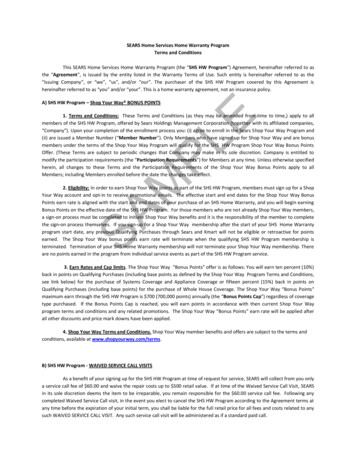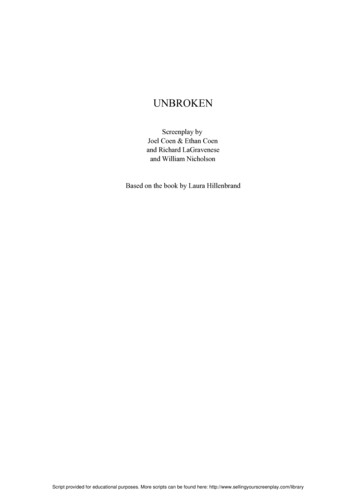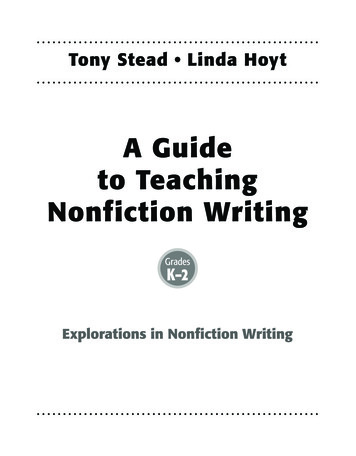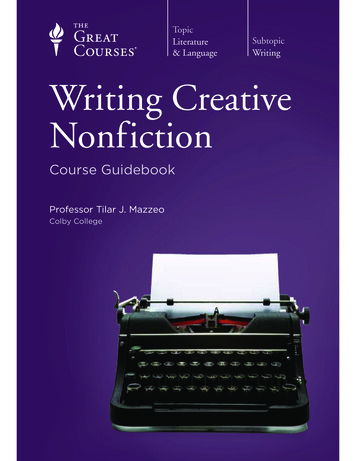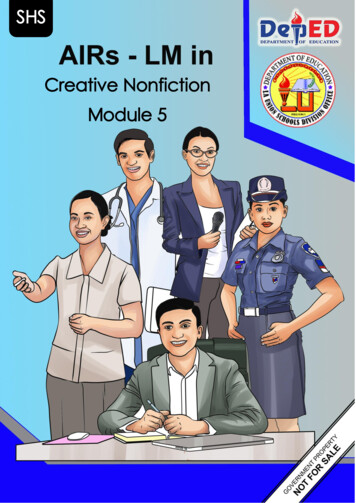
Transcription
SHSCreative NonfictionModule 5
HUMMS - Creative Non-FictionModule 5First Edition, 2020Copyright 2020La Union Schools DivisionRegion IAll rights reserved. No part of this module may be reproduced in any form withoutwritten permission from the copyright owners.Development Team of the ModuleAuthor: Reynosa S. AcostaEditor: SDO La Union, Learning Resource Quality Assurance TeamIllustrator: Ernesto F. Ramos, Jr., P IIManagement Team:ATTY. Donato D. Balderas, Jr.Schools Division SuperintendentVivian Luz S. Pagatpatan, Ph.DAssistant Schools Division SuperintendentGerman E. Flora, Ph.D, CID ChiefVirgilio C. Boado, Ph.D, EPS in Charge of LRMSBelen C. Aquino, Ph.D, EPS in Charge of EnglishMichael Jason D. Morales, PDO IIClaire P. Toluyen, Librarian II
Creative Non-FictionModule 5
TargetCreative nonfiction can be described as a hybrid genre that pulls inelements of fiction (literary techniques), the writer’s perspective, andfactual information. It is a concept that offers great flexibility and freedom,while adhering to the basic tenets of nonfiction writing. In creativenonfiction, writers can be poetic and journalistic simultaneously.In your previous lesson, you are done with writing a draft of a shortpiece using the literary conventions of genre.This module will let you evaluate other’s drafts based on:1. Clarity of idea2. Appropriate choice of literary element3. Appropriate use of the element4. Effective combination of the idea and the chosen literary elementAfter going through this module, you are expected to:Revise the draft of a short piece using any of the literaryconventions of a genre (e.g. plot for narrative piece)1
Module5Evaluating Other’s Draft(Taken from:https://www.google.com)The students are evaluating each other’s drafts to improve overalllearning by helping them become better readers, writers, and collaborators.In Module 4, you are done with writing a draft of a short piece usingthe literary conventions of genre.2
JumpstartActivity 1: Agree or Disagree!Anticipation Reaction GuideDirection: The following statements enable you to gauge your level ofunderstanding about clarity of ideas and the literary elements of CreativeNonfiction . You are required to agree or disagree with each of the followingstatements. You will answer the activity in a separate sheet of paper dividedinto two columns. The first column will be labeled Before the module study andthe second column will be labeled After the module study. Place a check mark( ) on the Before the Module Study column if you agree with the statement anda cross (X) if you do not agree. Leave the After the Module Study column foryou will answer it in the later part of this module.Before theModuleStudyStatement1. Accuracy is the same with clarity.2. It’s okay to make readers work throughthe implications of what you’re saying.3. The longer the sentence is, the more complex it isto understand its meaning.4. To make a thought simpler, provide examples tothe readers.5. When examples are fun and topical, readers paymore attention.6. Writers of creative nonfiction base their stories onreal events.7. Extensive research is needed so as not tocompromise the truthfulness of the events.8. To emphasize critical moments, writers slow downor speed up the pace of the story.9. The most commonly used point of view for creativenonfiction is second person.10. An engaging dialogue grant characters a degree ofindividuality.3After theModuleStudy
Activity 2: Open Notes!Direction: Recall the literary elements of Creative Nonfiction and theirdefinition that you are aware off. Write your answers in a separate sheet ofpaper.Notes Box4
Activity #3: Fill Me!Direction: Fill the following graphic organizer with the three (3) best ideas tomake your narrative written output clear. Give an example to illustrate youridea. Use a separate sheet of paper for your answer by copying the graphicorganizer in it.How can weachieve clarity ofideas?5
Discover1. How to make our ideas clear in creative nonfiction?Clear writing is a writing that readers can follow.It’s okay to make readers work through the implications of what you’resaying, but it’s not okay to make them piece together what you’resaying in the first place.Readers must easily understand every point.We'll explore two tools for increasing clarity:Simple sentencesExamples and CounterexamplesSimple SentencesYou use plain phrasing.You use fewer ideas per sentence.Use plain phrasing where possible.Here’s a sentence with complex phrasing:"The obstacle facing media organizations is to chart aneconomically sustainable course through a landscape of commodityjournalism.”Let’s rewrite that sentence plainly:“News companies are having a hard time staying in businessbecause anyone with a blog or Twitter account can report the newsnow."Simplify your sentences without dumbing down your ideas.Use fewer ideas per sentence.Consider this bad paragraph:“There is a fast-growing collection of data describing the structure andfunctional capacity of human gut bacteria in a variety of conditions. Ongoingefforts to further characterize the multitude of functions of gut bacteria andthe mechanisms underlying its interactions will provide a betterunderstanding of the role of the microbiome in human health and disease.”Let’s rewrite it:“There’s a lot of research on gut bacteria. We’re quickly learning whatroles bacteria play and how they interact with each other. Researchers wantto better understand how these bacteria affect our overall health.”6
The original paragraph's sentences contained two ideas each. That’s aproblem. Your brain interprets the meaning of a sentence after it's donereading it. So, the longer the sentence, the more details you hold in yourhead at once. That makes understanding a complex point even harder.Don't be mean to your readers. Make it effortless to read your words.Beware rephrasingWhen authors restate a point, they point it out:“In other words ”“That is to say ”“Put another way ”These are often red flags: the point that came before needed to be rephrasedto be understood.Instead, delete the rephrasing and reword the original statement to be self evident: use plain wording and use fewer ideas per sentence.If simplification can't achieve the necessary clarity, it's time to provideexamples.Provide examplesProviding examples is another tool for improving clarity. Examples makeabstract statements specific. Your brain best remembers things this way.A few tips for providing examples: Provide before and after examples, or counterexamples, to clarify whatyou don’t mean. Help readers orient themselves on a spectrum of rightand wrong.If you make examples fun and topical, readers pay more attention.Examples with many moving parts should be diagrams.Don’t waste time with examples if you’re confident your point was selfevidentTakeaways for clear writing If you write something unclear, you're writing for an audience of one:yourself. You might as well be writing in your diary.Instead, be clearer than you think is necessary. Use simple wording,use simple sentences, and provide examples.Simple language doesn't weaken your writing. It strengthens yourpoints by helping what matters stand out.7
2. What are the elements to choose from when writing nonfiction?a. ReflectionThe subjects in this genre usually center on events ofpersonal significance to the writer. For this reason, narrativenonfiction commonly exhibits elements of narrative reflection—writers provide their thoughts and views on the events andexperiences that have colored their lives. Writers may alsocomment on the manner in which these experiences and peoplehave influenced other aspects of their lives. In such cases, works ofnarrative nonfiction resemble the nonfiction genres of memoir orthe personal essay because they serve as a platform for the writer’spersonal views and opinions.b. Accuracy and ResearchFirst and foremost, writers of narrative nonfiction base theirstories on real events. Although narrative nonfiction typicallyreflects on the personal experience of the writer, a writer mustaccurately convey the people, places, and events that occur withinthe narrative. As a result, a writer may need to conduct extensiveresearch so as not to compromise the truthfulness of the eventsand people discussed. Writers must fluidly and creatively blendaccurate, researched-based details with narrative story-tellingtechniques.The biography is another type of nonfiction that overlapswith narrative nonfiction as far as attention to facts. Like writers ofnarrative nonfiction, writers of biographies research details toensure that their work is truthful and accurate. Unlikebiographies, however, narrative nonfiction provides writers withmore creative license to depict people, places, and events.c. CharacterizationSimilar to characters in a fiction narrative, characters in awork of nonfiction can be dynamic and undergo meaningful growthand change. The author may recall a memory of a person and usepersonal perception to further develop the character. The flexibilityof the narrative nonfiction genre allows the writer to fictionalize orblur certain elements of a character or event. Because a writerdoesn’t know the full and truthful motives or thoughts of a person,this genre gives license for writers to develop and fictionalizecertain features of an actual person.Writers may use engaging dialogue to make charactersdistinct from one another and grant them a degree ofindividuality. Narrative nonfiction allows the writer to develop aparticular conflict (such as character versus society) for charactersthat may simplify or not precisely portray the person’s actual life.8
d. PlotThe plot of a narrative nonfiction work may follow thestructure of a fictional novel, starting with the element of expositionand moving on to rising action, climax, falling action, andresolution. This narrative structure allows the writer to bringcohesion and resolution to real-life events that may not have beenso clearly defined.e. Narration and Point of ViewSometimes works of nonfiction, like biographies, maychronicle the life of a person over a span of years. In narrativenonfiction, writers use techniques such as time sequencing tojump to or between critical parts of the story. The writer may alsouse flash-forward or flashback to move through the plot. Narrativepacing also enables writers to slow down or speed up the pace ofthe story to emphasize critical moments.As with other narrative forms, writers of narrative nonfictioncan use different narrative point of views, but first person andthird person are the most common. First-person narration enableswriters to express their personal views about real-life people andevents. In third person, the perspective is limited for writersbecause they cannot accurately understand the internal thoughtsand motivations of the real people represented by theircharacters. Instead, writers must use what they've learned orobserved about the actual people to develop the characters andevents.9
ExploreEnrichment Activity 1: Am I Clear?1.2.3.Write the letter of the clearer statement in a separate sheet of paper.a. Extra-solar planet systems can be formed in two ways. In the first, aterrestrial mass planet forms in the inner disk, while a gas giant formsbeyond the snow line. During the inward migration of the gas giant, theterrestrial planet is captured in a mean motion resonance where itremains until migration ceases. In the second, a gas giant can migratethrough a disk of planetismals (minute planets). This results in meanmotion resonances with the gas giant sweeping through the disk ofplanetismals, causing material to be either scattered out of the system orcaptured into these resonances.b. Extra-solar planet systems can be formed in two ways: the first iswhen a terrestrial mass planet forms in the inner disk, while a gas giantforms beyond the snow line, causing the terrestrial planet to be capturedin a mean motion resonance during the inward migration of the gas giantwhere it remains until migration ceases. Alternatively, a gas giant canmigrate through a disk of planetismals, resulting in mean motionresonances with the gas giant sweeping through the disk of planetismals,causing material to be either scattered out of the system or captured intothese resonances.a. The current upsurge in stakeholder dissatisfaction with the outcomesof local government decision-making is at least partially a consequence ofthe predilection against long term planning.b. The current rise in stakeholder dissatisfaction with local governmentdecisions is at least partly due to the lack of long term planning.a. Just as we see the events of the novel through Jane’s eyes, we onlylearn the story of Mr. Galvez and Berta through what Mr. Galvez tellsJane, which Jane then tells the reader. As Berta’s voice is excluded, it iseasy to believe Mr. Galvez’ version.b. Just as the events of the novel are shown to us through Jane’s eyes,we only learn the story of Mr. Galvez and Berta through what Mr. Galveztells Jane and Jane tells the reader. As Berta’s voice is excluded, Mr.Galvez’ version is easily believed.10
4.a. Measurement of scanner performance can be achieved throughexamination of four criteria: resolution, bit-depth, dynamic range andsoftware.b. Scanner performance can be measured by examining four criteria:resolution, bit-depth, dynamic range and software.5.a. Breitman argues that when Eichmann and Dannecker talked of a“final solution” in 1941, they must have intended mass murder. Heclaims that , as Heydrich had submitted a proposal to Hitler before theend of January, this must have been when the Final Solution wasconcretely adopted.b. Breitman argues that because Eichmann and Dannecker talked of a“final solution” in early 1941, this must have meant that they intended aprogram of mass murder. He substantiates this claim by pointing outthat Heydrich had submitted a proposal to Hitler before the end ofJanuary; therefore, this must have been the time that the Final Solutionwas concretely adopted.Assessment Activity :Direction: Write the CAPITAL letter of your answer in a separate sheet ofpaper.1. People have different ways of learning. Some are better at making mentalpictures of new ideas. Others are more comfortable with writing lists of things tomemorize. Certain people can learn best when listening to music, while othersneed silence to concentrate. Which of the following is the main idea of thepassage?A. Mental pictures help many to learn.B. Some people prefer lists to making mental pictures.C. To learn well you need to be comfortable.D. Different individuals have different ways of acquiring information.2. If you hold a piece of copper wire over the flame of a wooden match, heat willbe conducted by the copper wire to your fingers, and you will be forced to dropthe wire. You will, however, still be able to hold the match because wood is apoor conductor of heat. Which of the following is implied in the passage above?A. Copper is a good conductor of heat.B. Matches should be made of copper.C. Wood and copper conduct heat equally.D. Wood is an excellent conductor of heat.11
3. Cesar Chavez was an influential leader for farm workers. He fought fortheir rights and better working conditions. Chavez led many strikes thatangered farm owners. Eventually he succeeded in getting increased wagesand better living situations for farm workers. The passage indicates thatChavez changed lives by .A. fighting for the rights of farm ownersB. helping to end the farm workers’ strikesC. improving the conditions for farm workersD. working on the farms every day4. Many people own different pets. Dogs, cats, birds, and fish are commonhousehold pets. Others’ pets are considered to be exotic animals. These includesnakes, lizards, and hedgehogs. According to the passage, snakes are .A. found only in zoosC. uncommon petsB. to be found in a household with dogs D. not allowed in people’shomes5. When cartoonist Charles M. Schulz was a boy in elementary school, otherboys teased him for being small and not very good at sports, and his artteacher told him he had no talent for drawing. He had few friends and wastoo shy to talk to a red-haired girl he admired. Later in life, Schulz used hischildhood experiences in his comic strip Peanuts: the strip’s main character,the sad and lonely Charlie Brown, represents Schulz as a little boy. Peanutswas unique at the time because it contained no adult characters. Readers fellin love with Charlie Brown, and Peanuts eventually became one of the mostpopular comic strips of all time. What is the main idea of the passage?A. Peanuts was the world’s most widely read comic strip.B. Schulz was a very famous cartoonist.C. Schulz turned the pain of his youth into success as an adult.D. The comic strip Peanuts featured children as its only characters.6. Before giving first aid to an accident victim, you should obtain his or herconsent. Asking for consent takes a simple question. Say to the victim, “Iknow first aid, and I can help until an ambulance arrives. Is that okay?”According to the passage, it is wrong to .A. use first aid on an accident victim without medical trainingB. attempt to help an accident victim without permissionC. help a victim before an ambulance arrivesD. call for an ambulance instead of helping the victim7. Dr. Ellen Ochoa is an inventor and is also the first female Hispanicastronaut. Her inventions include technology to help robots inspect equipmentin space to maintain safety and quality control on spacecraft. Before retiring,she logged more than 1,000 hours in space across several space missions.According to the passage, Dr. Ochoa is the first .A. Hispanic person to travel into space C. woman to travel into spaceB. inventor to travel into spaceD. Hispanic woman to travel intospace12
8. Dogs and cats make very different types of pets. Before deciding whether tobuy or adopt a dog or a cat, prospective owners need to carefully considertheir own lifestyles and personalities. Dogs may make more affectionatecompanions, but they require more care and attention. They must be taken outseveral times a day and should not be left alone for more than a few hours.Larger dogs require significant exercise to remain fit and healthy. Cats areusually more independent in nature and interact less with their owners. Also,a cat can be left on its own all day, or even for several days, as long as it hasfood and clean water to drink. From this passage, a reader can concludethat .A. owning a cat requires less work than owning a dogB. people who are away from home during the day should not own a catC. people who like to play with their pets should own a catD. owning a cat is more responsibility than owning a dogEnrichment Activity 2: Arrange Me!Direction: If you are to arrange the sentences to form a comprehensiveparagraph, what could be the arrangement? Write the CAPITAL LETTER ofyour answer in a separate sheet of paper.1.1. There was desultory conversation, but after a while, a silence fell andwe sat waiting, waiting---waiting.2. Every chair was filled and some patients were standing.3. Finally an old man stood up and remarked, “Well, I guess I’ll go homeand die a natural death.”4. I had been sitting in the doctor’s waiting room for a long time.A. 1234B. 3241C. 3124D. 42132.3.1.If you get a present that does not interest him, then your choice of agift is a poor one.2. If you select something that he can enjoy or use, he will appreciate it.3. Whatever the occasion, you should remember what a person likeswhen you buy him a present. That way you can buy an appropriate gift.4. Whenever you buy a gift, you should always consider the interests ofthe receiver.A. 1234B. 3241C. 3124D. 43211. A computer is basically a machine that can make extremely fastcalculations, millions of them a second, and can store facts in itselectronic memory to use in those calculations.2. For if the programming is wrong, then the answers will be wrong.3. However, computers can only do what they are told to do. They mustbe instructed or “programmed.”4. It is said, with some justice, that a computer is no better than theperson who runs it.A. 2134B. 1342C. 3124D. 432113
4.1. It shovels information at us in such quantities so relentlessly and withsuch impact, we believe it instead of believing our own guts.2. Television has lied to us about ourselves.3. We find it harder to understand each other.4. We find it harder to understand ourselves.A. 3412B. 1342C. 3124D. 21345.1. Allow plenty of time to get ready so that you wouldn’t be late for yourinterview.2. Before you leave the house, check whether you have a pen or an extrapersonal data sheet.3. Dress appropriately and observe proper grooming to create a goodimpression.4. To prepare for an interview, sleep early in order to be at your best,both physically and mentally.A. 1324B. 2134C. 3421D. 41326.1. If you have a green thumb, the rewards are two-fold.2. If you intend to spend your lazy afternoon in quiet, placid hobbies,gardening would be your best choice for such leisure time.3. It relaxes you through your communion with nature.4. There is no joy comparable to that of harvesting your own crop andsetting it on the table for all to see and enjoy.A. 1243B. 2134C. 3124D. 4321Enrichment Activity 3: Simplify Me!Direction: Choose the best paraphrase from each set of choices. Write theCAPITAL LETTER of your answer in a separate sheet of paper.1. Of the 138 million acres of land that Native Americans owned in 1887, 90million acres were taken away by whites by 1932.A. Native Americans owned 138 million acres of land in 1887, whereaswhites had only 90M acres.B. In 1932 alone, the white settlers took 90 million acres of land thatbelonged to Native Americans.C. By 1932, Native Americans had lost almost all of their land.D. Native Americans owned in 1932 a little more than half of the landthey had owned in 1887.2. Martha thinks that the issue of adolescent problems is important to writeabout.A. Martha believes that the dream of most adolescents is to writesomething important.B. Martha thinks that adolescents like to write about their problems.14
C. Martha feels that writing about adolescent problems is worthwhile.D. Martha thinks that adolescents can write about their problems.3. Research data suggest that girls who witnessed maternal abuse may tolerateabuse as adults more than girls who did not.A. Women who witnessed the abuse of their mother as teens are morelikely to become abusive adults.B. Women who observed the abuse of their mothers when they wereyoung are more likely to endure abuse themselves.C. Girls who testify about maternal abuse tolerate abuse as adults morereadily.D. Women who were abused as children are more likely to abuse theirown children.4. A woman who was nominated by the president to head the department wasquickly approved by the board of trustees.A. The board of trustees agreed with the president to appoint a womanhead of the department.B. The president quickly approved the decision of the board of trustees.C. The woman and the president approved the decision of the board oftrustees.E. The board of trustees approved the woman's interest in being head ofthe Department.DeepenActivity 1: Quick QuotableDirections: Use a separate sheet of paper for your answers on this activity.a. On the left side of the column, write five (5) to six (6) of your most favoritequotes from people you admire. Write the author’s names below them.b. In the adjoining column (middle), write your interpretation of the quoteand why it appeals to you.c. If you are feeling good about it, write down why you consider it a greatquote and write your own ideas about it that are important to you in thelast column(right).15
Favorite QuotesYour OwnInterpretationWhy It Appeals to you/Why do you consider ita great quote1.2.3.4.5.6.Activity 2: Daring DoodlesI am challenging you to draw your understanding of the concept“CREATIVE NONFICTION.” The scoring rubric on the next page will beused in assessing your outputs.16
17
Rubric for the 5Drawing isexpressive anddetailed.Shapes,patterns,shading/texture areused to addinterest to thedrawing.Student hasgreat controland is able toexperiment.Studentapplies designprinciples(unity, contrast,balance,movement,direction,emphasis, andcenter ofinterest) withgreat skill.4Drawing isexpressive andsomewhatdetailed. Littleuse has beenmade ofpattern,shading, ortexture.Student hasbasics, but hadnot “branched”out.Studentapplies designprinciples(unity, contrast,balance,movement,direction,emphasis, andcenter ofinterest) withfair skill.3Drawing hasfew details. Itis primarilyrepresentational with verylittle use ofpattern,shading ortexture.Student needsto improvecontrol.Studentapplies designprinciples(unity, contrast,balance,movement,direction,emphasis, andcenter ofinterest) butthe overallresult is notpleasing.The artworkthe artworkThe artworkdemonstrates a demonstrates a demonstrates achallengingsatisfactorybasic level oflevel oflevel ofattention toproduction and production and production,creativity ascreativity ascreativity, andwell aswell as logicalproblemoutstandingproblemsolving skills.problemsolving skills.solving skills.2The drawinglacks almostall detail orit is unclearwhat thedrawing isintended tobe. Studentneeds towork oncontrol.The studentdoes notappear to beable to applymost designprinciples tohis/her ownwork.The artworkdemonstrates very littleattention toproduction,creativity,and problemsolvingskills.Total ScoreComment/s:18
.19
GaugeActivity 1: Work It Out!Direction: Read and answer carefully. Use another sheet of paper for youranswers.a. Write your opinion on the situation given. If you are to choose two(2) literary elements to be used in your output in CreativeNonfiction, what would they be and why?b. Apply these literary elements you have chosen to make an output.c. Read your output silently. Do you think you used the appropriateliterary elements in your output? Justify your answer.d. Was there an effective combination of the idea and the chosenliterary element/s? Justify your answer.e. Exchange output with one of your classmates. Judge/Assesshis/her output by answering the same set of questions startingfrom c to d.Activity 2: Let’s Talk it Over!Direction: Discuss the importance of having clear ideas when writing creativenonfiction. Write your answer in a separate sheet of paper.20
Activity 3: Agree or Disagree!Anticipation Reaction GuideDirection: The following statements enable you to gauge your level ofunderstanding about clarity of ideas and the literary elements of CreativeNonfiction. You are required to agree or disagree with each of the followingstatements. You will answer the activity in the same separate sheet of paperthat you used earlier. Place a check mark ( ) on the After the Module Studycolumn if you agree with the statement and cross (X) if you do not agree.Before theModuleStudyStatement1.Accuracy is the same with clarity.2. It’s okay to make readers work throughthe implications of what you’re saying.3. The longer the sentence is, the more complex itis to understand its meaning.4. To make a thought simpler, provide examples tothe readers.5. When examples are fun and topical, readers paymore attention.6. Writers of creative nonfiction base their storieson real events.7. Extensive research is needed so as not tocompromise the truthfulness of the events.8. To emphasize critical moments, writers slowdown or speed up the pace of the story.9. The most commonly used point of view forcreative nonfiction is second person.10. An engaging dialogue grant characters adegree of individuality.21After theModuleStudy
APPENDIX AKey AnswerEnrichment Activity 11. B2. B3. B4. B5. AAssessment Activity1. D2. C3. C4. C5. C6. B7. D8. AEnrichment Activity 21. D2. D3. B4. D5. D6. BEnrichment Activity 31. B3. B2. C4. A22
REFERENCESPrintedArciaga, Maximina L. et al. 2010. Literatures of the Philippines. Baguio City:Saint Louis University.Medriano Jerome P. (2020) Rubrics in Writing a Story Analysis. Retrieved July25 from http://rubistar.4teachers.org/index.phpMurcia, Loren (2015) Action Research on Student and Pupil Absenteeism inSchool. Retrieved September 2 from https:// www.google.comMurray, Andrew V. 2008. High School Subjects for Self- Study. Quezon City:Success Unlimited Enterprises.Website ets/style purpose strategy/writing /5-types-rubrics-use-artclasses/23
Creative nonfiction can be described as a hybrid genre that pulls in elements of fiction (literary techniques), the writer’s perspective, and factual information. It is a concept that offers great flexibility and freedom, while adhering to the basic tenets of nonficti

